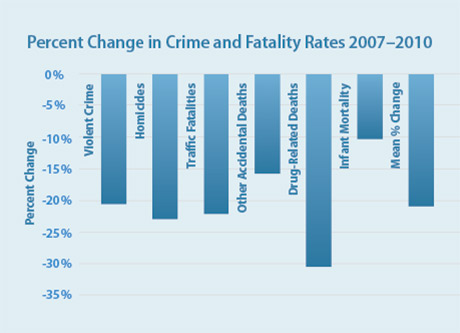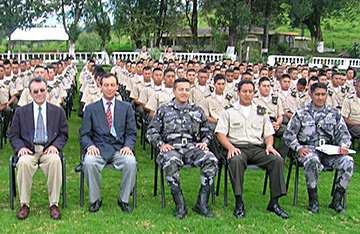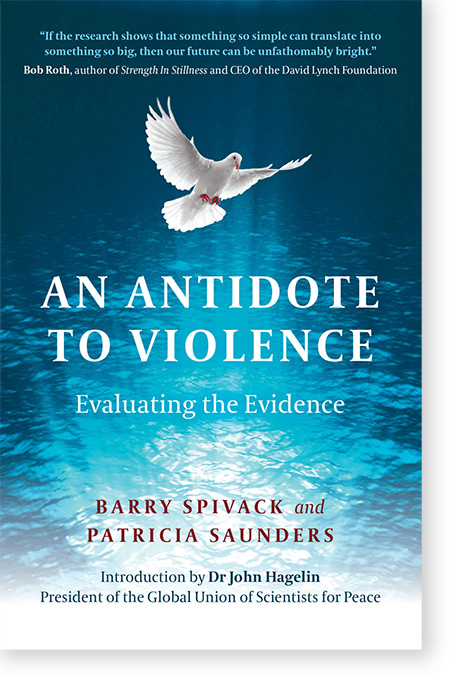The COVID-19 pandemic has put societies everywhere under extreme stress, and collective stress is often a precursor to outbreaks of violence. Striking features of this global health crisis include the collective anxiety of nations, the wide variations in the way governments have responded, and their varying degrees of success.
While there is significant scientific research showing that the Transcendental Meditation (TM) technique has a positive influence on the health and well-being of individuals, is there any evidence that TM practice by large numbers of people can also influence societies in reducing stress and levels of violence?
Yes is the conclusion from the authors of a new book published in June, 2020.
An Antidote to Violence: Evaluating the Evidence examines scientific research showing that the level of collective anxiety and tension in society is the key element that determines the success or failure of a government in tackling crime, violence, social unrest, and ill health.
Is there any evidence that TM practice by large numbers of people can also influence societies in reducing stress and levels of violence? Yes.
An Antidote to Violence
Authors Barry Spivack and Patricia Saunders, Ph.D., describe how a rise in collective tensions spills over into increased social unrest, crime, violence, accidental deaths, and hospital emergencies. They examine 20 peer-reviewed studies from over four decades, indicating that it is possible to neutralize or reduce stress in collective consciousness through the practice of the TM program by a sufficient number of individuals, an effect that is amplified in groups.
This reduction in collective stress leads to decreases in violent crime and war fatalities, and increases in quality of life and cooperation between nations. Researchers named this phenomenon of rising coherence in the collective consciousness of a community or society the “Maharishi Effect,” after TM Founder Maharishi Mahesh Yogi, who predicted this effect in the 1960s.
The Maharishi Effect was first studied and validated by scientists in 1974, when the number of people participating in the TM program in twelve U.S. cities reached 1 percent of the population, and rising crime rates in those cities began to drop.
The term now includes the influence generated by group practice of the advanced TM-Sidhi® program, through which even the square root of 1 percent of a community is sufficient to create measurable changes in social trends. Published research confirms that collective practice of the TM and TM-Sidhi programs by large groups of trained experts neutralizes societal stress.
“This research has been replicated on a multitude of variables, in many different cultures and countries, showing holistic effects.” —Dr. David Orme-Johnson
David Orme-Johnson, Ph.D., one of the principal researchers on the TM program worldwide, commends the book: “This hypothesis has been tested and verified by over 50 studies on the levels of cities, states, nations, and the whole world. Spivack and Saunders carefully review the evidence and alternative explanations for the 20 strongest studies published in peer-reviewed journals. This research has been replicated on a multitude of variables, in many different cultures and countries, showing holistic effects.”
Evaluating the Evidence
“These findings are more relevant now than ever before, at a time of pandemic and social unrest,” says Spivack, offering three examples from the studies cited in the book. Each of these experiments consisted of large numbers of people practicing the TM program on their own or in groups for a period of weeks or months, and in some cases years, in societies wrestling with violence:
- on 93 experimental days in Lebanon and Israel, between 1983 and 1985;
- in Cambodia, between 1990 and 2008;
- and in the United States, between 2007 and 2010, compared with the previous four years.
In each case, statistically significant drops in violence occurred during the periods when the numbers practicing the TM and TM-Sidhi programs were above the predicted threshold of the square root of 1 percent of the national population.
The Lebanon and Israel study, for example, was published in the top journal in the field, Yale University’s Journal of Conflict Resolution. It measured the effects of a group of practitioners of the TM and TM-Sidhi programs in Jerusalem on a composite index of quality of life. When the group got bigger, crime, traffic accidents, fires in Israel, war fatalities, and war intensity in Lebanon correspondingly decreased. War intensity in Lebanon decreased by 45 percent and war fatalities decreased 75.7 percent.
The Cambodia study found that when a group of practitioners of the TM and TM-Sidhi programs reached the requisite number, there was a marked downward shift in the trends of socio-political violence and other forms of violent crime, contrary to predicted baseline trends as well as community and media expectations.

In 2007–2010, the experimental period for this study, U.S. rates of homicides, motor vehicle fatalities, drug-related deaths, violent crime, fatalities due to other accidents, and infant mortality decreased compared to the baseline period. (Credit: Maharishi International University)
In the United States study, during the experimental period from 2007 to 2010 (see chart), U.S. rates of homicides, motor vehicle fatalities, drug-related deaths, violent crime (homicides, aggravated assault, robbery, and rape), fatalities due to other accidents, and infant mortality all decreased, compared to the baseline period, when the threshold number was reached.
This is the first book that examines all the peer-reviewed research and looks at the implications of the research as a whole, rather than just individual papers. “Compiling so many consistent experimental results may indicate more than a statistical correlation; it justifies further research into a causal hypothesis,” say the authors.
Written for both social scientists and general readers, An Antidote to Violence offers answers to key questions:
- Does group TM practice influence society?
- What is the evidence?
- How does it work?
- What do skeptics say?
Weaving together psychology, sociology, philosophy, statistics, politics, physics, and meditation, the book provides evidence that we have the knowledge to reduce all kinds of violence in society by creating coherence in collective consciousness and thereby neutralizing collective stress.
The book provides evidence that we have the knowledge to reduce all kinds of violence in society by creating coherence in collective consciousness and thereby neutralizing collective stress.
“Defeating the Virus of Violence”
Quantum physicist John Hagelin, Ph.D., president of Maharishi International University and the Global Union of Scientists for Peace, suggests, in his introduction to the book, “the existing research, while compelling and rigorous, presents a direct challenge to established mainstream sociological paradigms and may be difficult for some to accept. Even more rigorous and repeated testing of the theories presented here is therefore essential to ensure widespread acceptance of this demonstrated sociological phenomenon.”
Dr. Saunders agrees. “We have three aims for the book,” she explains: “We want to inspire scientists to investigate collective consciousness. We also want to inspire them to investigate peer-reviewed research, which suggests that the Transcendental Meditation technique and its advanced programs can influence collective consciousness in a positive direction. And we want to encourage governments to create the Maharishi Effect in their own countries, not only for the sake of their country, but also to establish peace in the world.”
“Just as we must explore every scientific means for beating COVID-19, we must also follow every lead for defeating the virus of violence.”
—Tim Ward, Publisher, Changemakers Books
Changemakers Books publisher Tim Ward, who was struck by the book’s thought-provoking premise, gives his reasons for publishing it: “While the evidence gathered in this book is striking, more research needs to be done to prove it true. And that’s why I chose to publish An Antidote to Violence. Too much is at stake to let this possibility slip through our fingers. Just as we must explore every scientific means for beating COVID-19, we must also follow every lead for defeating the virus of violence.”
Key Evidence That the TM Program Lowers Violence
Spivack points out many reasons “why the research provides evidence for the hypothesis that the Transcendental Meditation program reduces conflict and divisions in society and improves economic performance.”
In 20 peer-reviewed studies showing statistically significant results, the TM program is indicated to be an independent variable. Since the numbers of people practicing at any given time vary randomly in these experiments, it is possible to see if there is a repeat effect whenever the predicted threshold is reached, and there is.
Additional evidence that the TM program is an independent variable is that the number of TM practitioners changes before changes in the dependent variables, such as crime rate, war fatalities, or the misery index (a measure of how an average citizen is doing economically).
The studies also show what scientists call a dosage effect: The bigger the group practicing the TM program at any given time, the larger the impact.
Last but not least, the studies controlled for other possible causes for these changes, such as population density, education, and per capita income; the ratio of police to population; weather, holidays, and political events; and demographic factors (e.g., unemployment rates or percentage of population aged 15 to 29).
In 20 peer-reviewed studies showing statistically significant results, the TM program is indicated to be an independent variable.
What Military Leaders Say about An Antidote to Violence
“I was initially skeptical that such a simple solution could be effective,” says Lieutenant General Clarence E. McKnight, Jr., Former Director of Command, Control, and Communications Systems for the Joint Chiefs of Staff, Washington, D.C. “However, after examining the evidence, I changed my mind. An Antidote to Violence is a serious and well-researched book that offers an unconventional but effective peaceful solution to violence and terrorism.”

In Ecuador, soldiers at the military police training academy practice the TM program
Lieutenant General Vasyl Krutov, former First Deputy Head of the Security Service of Ukraine and First Deputy Secretary of the National Security and Defence Council of Ukraine, says that “Barry Spivack and Patricia Saunders address the challenges of preventing violence and war with a high level of professionalism, and, by examining a means to achieve sustainable peace supported by long-term research, have created a book that is hugely relevant. Most importantly, they highlight the interdependence of power, violence, security, and individual and collective consciousness.”
Lieutenant General José Martí Villamil de la Cadena, former Chief of Staff of the Army and Commander of Ground Theatre Operations, Chief of Staff of the Joint Command, Vice-Minister of Defence, and General Secretary of the National Security Council in Ecuador, says, “My most sincere congratulations to the authors for their research and presentation of this book. I hope it will be read and applied by leaders of government and by all in general for the good of society and each person in particular.”
“An Antidote to Violence is a serious and well-researched book that offers an unconventional but effective peaceful solution to violence and terrorism.” —Lt. Gen. Clarence E. McKnight, Jr.
About the Authors of An Antidote to Violence

Barry Spivack studied philosophy, politics, and economics at Oxford University before training as a teacher of the Transcendental Meditation technique. He teaches TM courses in Essex, mainly in schools, companies, and for patients in the U.K. National Health Service. He lives in Woodbridge, Suffolk, United Kingdom.

Patricia Saunders, Ph.D., is a researcher in the department of Maharishi Vedic Science at Maharishi International University, conducting research on consciousness and Vedic sound from the perspective of the Vedic tradition of knowledge. She lives in Fairfield, Iowa.



Comments
you may also like
Science & Research
Can My TM Practice Help Create a More Peaceful World?
Q&A with renowned TM researcher Dr. David Orme-Johnson on a scientific, brain-based approach to peace. He explains how the TM and TM-Sidhi programs have been shown to help reduce rates of crime, accidents, mortality, war, and terrorism.
Science & Research
Global Peace Summit Offers Solutions to Terrorism
We need new solutions to rising terrorism. In Kiev, 600 scientists and leaders explore innovative, evidence-based approaches to preventing war, achieving national security, and promoting regional and global peace.
DLF.org
A New Science for Peace: Conference Replay (3:29:01)
Join Candy Crowley, Dr. John Hagelin, and experts in health, brain science, education, and the military as they discuss the use of the evidence-based TM® technique to address the critical issues of toxic stress, trauma, and peace at the Abramson Center for Peace, David Lynch Foundation, Washington, D.C.
Personal Growth
Q&A with Dr. John Hagelin: Influence at a Distance—Creating Peace from the Quantum Level | 34:07
On March 25, 2018, about 55,000 participants in the second Global TM Group Meditation listened to Dr. Hagelin, quantum physicist and President of Maharishi International University, as he explained how coherence in collective consciousness helps create world peace.